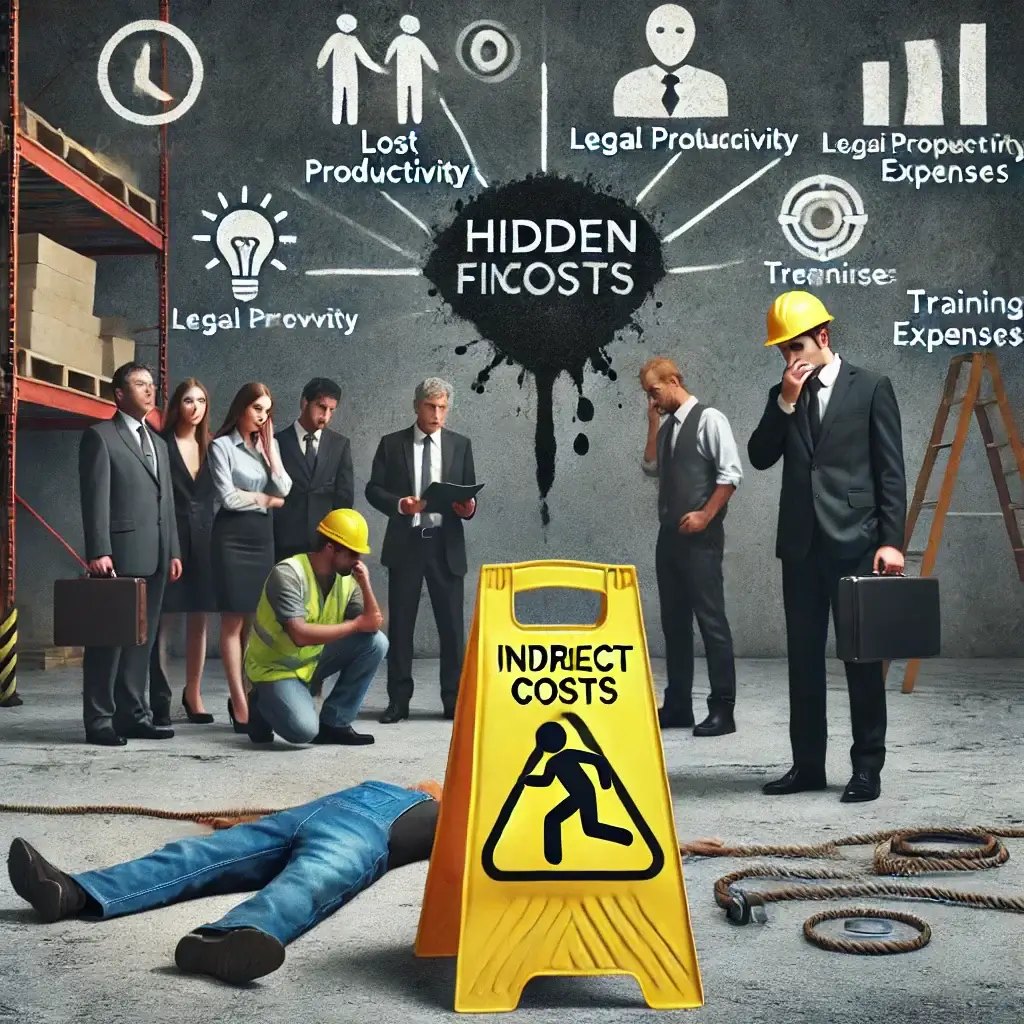Workplace accidents are more than a bump in the daily grind—they can have a ripple effect and impact a business in ways that aren't always immediately apparent. When we consider accidents at work, it's easy to think about the immediate things: medical expenses, broken equipment, or an employee taking a day off. Which of the following are considered indirect costs for workplace accidents? The ones that creep up later and slap the company in the face? Those are the indirect costs, and they can quickly add up. So, Which of the following are considered indirect costs for workplace accidents? Let's get into it and sort it out together.
In this article, we'll dissect what indirect costs actually are, look at some examples, and discuss why they concern businesses large and small. By the end of this, you'll have a solid understanding of how accidents in the workplace cost more than you realize—and why safety first is an intelligent decision for all.
H2: What Are Indirect Costs in Workplace Accidents?
Before we can say Which of the following are considered indirect costs for workplace accidents?, we have to understand what "indirect costs" is. Directly speaking, indirect costs are the costs that don't slap you in the face when something goes wrong. They're not the ride in the ambulance or the busted machine—they're the things that happen afterward, such as lost productivity or special training for a new employee.
These expenses are more difficult to see, but they might end up being much larger than the direct costs. Consider it this way: if an employee slips and injures their leg, the direct expense is the medical bill. But what about the time the team loses as they scramble to fill the shift? Or the time the boss loses filling out forms? Those are indirect costs, and they can add up fast. So, which of the following are indirect costs for on-the-job accidents?
Let's begin with some typical ones and observe how they work out.
H2: Examples of Indirect Costs You May Not Think Of
When you’re asking which of the following are considered indirect costs for workplace accidents?, it helps to look at real-life examples. Here are some big ones that businesses deal with all the time:
H3: Lost Productivity Picture this: a worker gets hurt, and suddenly the whole team is thrown off. Maybe they’re short-handed, or maybe everyone’s distracted worrying about their buddy. Either way, work slows down. That dip in output? That's an indirect cost. It's not a bill you incur, but it's money you're not earning. Lost productivity is a massive solution to Which of the following are considered indirect costs for workplace accidents?
because it occurs every time an accident puts a wrench in the workflow.
H3: Training Replacement Workers
If someone’s out for a while—or quits because they don’t feel safe anymore—you’ve got to bring in someone new. Training that person takes time and money. It’s not just their paycheck; it’s the hours a supervisor spends showing them the ropes instead of doing their own job. That’s another sneaky indirect cost. So, which of the following are considered indirect costs for workplace accidents? Training replacements definitely makes the list.
H3: Overtime Pay
When a worker’s down, someone else has to pick up the slack. That might mean paying overtime to keep things running. Overtime isn’t cheap—it’s usually time-and-a-half or more. It’s not a direct medical expense, but it’s a cost tied to the accident all the same. Add it to the pile when you’re figuring out which of the following are considered indirect costs for workplace accidents?
H3: Legal Costs and Penalties
If the accident was serious enough, you could land yourself in hot water with regulators or even find yourself in court. Legal expenses, settlements, or fines don't appear on the day of the accident—they sneak up later. These are typical indirect costs because they're associated with the aftermath, not the accident itself. So, when we ask Which of the following are considered indirect costs for workplace accidents? , legalities is a strong contender.
H3: Reputation Damage
Here's one that's more difficult to quantify: what happens when people find out that your workplace isn't safe? Customers may take their business elsewhere, or good employees may not want to apply. An injury to your reputation doesn't have a price tag, but it can set you back considerably in the end. It's another response to Which of the following are considered indirect costs for workplace accidents?
H2: Why Indirect Costs Are More Important Than You Realize You may be asking yourself why we're devoting so much time to this. I mean, if direct costs are the no-brainer ones, shouldn't they receive all the focus? Not exactly. Research indicates that indirect costs can be two to ten times greater than direct costs, depending on the accident. That's a big difference!
Therefore, when we say which words below qualify as indirect costs of workplace injuries,
We're referring to the things that can quietly tank a business if not addressed properly.
Let's say we're dealing with a small business. They can pay $1,000 for a doctor's bill (direct cost) in their sleep. But when they lose $5,000 in productivity and $3,000 training the replacement, it's a different ball game altogether. Indirect costs come out of nowhere and attack you on all sides, so it's important to drill down on which of the following are indirect costs for work injuries?
H2: How Direct Costs Accumulate?
Let's take it one step at a time with a scenario. So a warehouse hand steps on a loose cable and twists their ankle. The direct costs are obvious: an urgent care visit and a replacement cable. But then there are indirect costs. This is how they might add up:
The hand's out a week, so the crew is behind on order fulfillment. Loss of productivity.
Another worker puts in overtime to get back on schedule. Overtime pay.
The manager wastes hours filling out insurance reports. Time wasted.
The company receives an OSHA safety citation. Penalties.
A customer hears about the holdup and changes suppliers. Lost customer.
See how quickly it multiplies? That's why it's so crucial to determineWhich of the following are considered indirect costs for workplace accidents? It's not just a single action, it's a domino effect.
H2: Direct vs. Indirect Costs: How They Compare
To truly get a grip on Which of the following are considered indirect costs for workplace accidents? , it's helpful to compare them to direct costs. Here's a brief rundown:
Direct Costs: Medical expenses, equipment repair, workers' comp. These strike immediately and are simple to monitor
Indirect Costs: Lost time, decreased morale, recruitment expense, legal hassle. These have a longer lead time and are more difficult to quantify.
The difference? Direct costs are an immediate punch to the gut, whereas indirect costs are a gradual bleed. That's why companies must be concerned with both—and why which of the following are considered indirect costs for workplace accidents? continues to come up in safety discussions.
H2: How Can Companies Identify Indirect Costs?
If indirect costs are so subtle, how do you even identify them? They don't exactly appear on a bill marked "Accident Fallout." The key is to take a step back and look at the larger picture. When you're asking what of the following are indirect costs of workplace accidents?, begin by following what's changed after the accident. Are people working slower? Are you spending more for labor? Is your turnover increasing? Those are signs.
Certain firms even employ mathematical formulas to project indirect costs. They may, for instance, multiply direct costs by a ratio (such as 3 or 5) and estimate the total effect. It's far from ideal, but it's better than doing nothing. The trick is to quit avoiding asking Which of the following are considered indirect costs for workplace accidents? and begin searching for the answers.
H2: Preventing Indirect Costs Before They Happen
Here's the good news: if you know Which of the following are considered indirect costs for workplace accidents?, you can do something about it. Prevention is the best way to keep these costs from mounting. A good safety program—think training, regular inspections, and clear rules—can prevent accidents before they happen. Fewer accidents mean fewer indirect costs. It's that simple.
For instance, replacing that dangling cable in the warehouse could set you back $50 now. Put that in perspective with the thousands you'd lose if someone slips. Paying a little now prevents a lot later. So, Which of the following are considered indirect costs for workplace accidents?, the actual question is: how do we prevent them in the first place? H2: Real Stories of Indirect Costs in Action Let's bring this to life. One company I came across had an employee fall from a ladder. The direct expense was $2,000 for his visit to the emergency room. But the indirect expenses? They lost a $20,000 contract due to the delay, paid $1,500 in overtime, and spent $500 training a temporary worker. That's more than ten times the direct expense
It's an ideal illustration of which of the following are indirect costs for on-the-job accidents?
hitting harder than everyone anticipated.
Or consider a restaurant in which a cook scalded their hand. The doctor bill was $300, but the kitchen was dysfunctional for days—orders were confused, customers wrote negative reviews, and sales fell by $2,000. Another instance of indirect costs calling the shots. So, which of the following are indirect costs for accidents in the workplace? Anything and everything that makes the hurt linger beyond the time when the bandages are removed.
H2: Why Employees Feel Indirect Costs Too
It’s not just the business that gets hit. Workers feel it too. If morale drops after an accident, people might start slacking off or even quitting. That’s an indirect cost for the company (higher turnover), but it’s also a personal cost for the team. When you’re digging into which of the following are considered indirect costs for workplace accidents?, don’t forget the human side—stress, fear, and frustration all play a part.
H2: Wrapping It Up: Know Your Costs So, Which of the following are considered indirect costs for workplace accidents? We've just run through a whole list: lost productivity, training, overtime, legal expenses, damage to reputation, and so on. These aren't the glaring costs, but they're the ones that can secretly bleed a business dry. The bottom line? Workplace accidents cost you in ways you may not anticipate, and overlooking indirect costs is a risk no one can afford. The next time you're considering safety—or questioning whether it's really worth it—consider this: making people safe not only avoids injuries. It shields your bottom line, your crew, and your future. Indirect costs may be stealthy, but once you see Which of the following are considered indirect costs for workplace accidents? , you can't ignore them. And that's a good thing.
FAQ 1: What's the Difference Between Direct and Indirect Costs of Workplace Accidents?
Answer:
When a work accident occurs, the cost breaks into two bins: direct and indirect. The direct costs are the ones you see immediately—such as compensating a doctor visit or repairing a broken machine. They're the ones that are apparent to you. The indirect costs, however? Those are the sneaky ones that appear later. So, Which of the following are considered indirect costs for workplace accidents? Stuff like lost productivity while the team's scrambling, overtime to fill shifts, or even the time to train someone new because the injured worker can't return for a while. The main difference is timing and visibility—direct costs strike quickly and hard, but indirect costs linger and can end up costing a whole lot more. I mean, a $500 medical expense may not look good, but missing out on $5,000 worth of sales due to delayed orders? That's the indirect aspect that hurts most. Being able to identify which of the following constitute indirect costs of workplace accidents? enables companies to view the big picture and better plan.
FAQ 2: Why Do Indirect Costs Matter So Much for Businesses?
Answer:You may assume a workplace accident's harm ends at the emergency room, but that's only the beginning. Indirect costs are important because they can overwhelm the direct ones and continue to hurt long after the dust has settled. When you ask Which of the following are considered indirect costs for workplace accidents? , you’re looking at things like a drop in team morale, which slows everyone down, or the extra cash spent on lawyers if someone sues. Imagine a factory where a worker gets hurt—sure, the medical bill’s a direct hit, but what about the production line stalling for days? Or customers jumping ship because deliveries are late? Those are indirect costs, and they can accumulate to two or ten times the direct costs.
That's why companies can't afford to neglect which of the following are indirect costs for work-place accidents?
—they're the concealed leaks that will sink the ship if you don't plug them with sound safety habits.
FAQ 3: Can Indirect Costs Affect Employees Too, Not Just the Company? Answer: Sure enough, employees do not walk away from an accident unharmed—even if they are not the injured ones. When we considerWhich of the following are considered indirect costs for workplace accidents? , it is not entirely about the company's pocketbook. Granted, the company may lose a bit on retraining a replacement or fines, but the employees do too. Consider this: if one of your team members gets hurt, the rest of the team could begin to get anxious or tense, wondering if they're next. That atmosphere can kill morale, causing individuals to be less concentrated and more prone to screw up. And if the accident results in firings or a negative reputation, jobs may become unstable.
Which of the following are indirect costs of workplace accidents?
Stuff like lower team spirit, higher turnover, and that uneasy feeling that sticks around.
It’s a ripple effect—accidents hit everyone, not just the balance sheet. FAQ 4: How Can a Business Figure Out Its Indirect Costs After an Accident? Answer: Tracking indirect costs isn’t as simple as checking a receipt—it takes some detective work. When you’re asking which of the following are considered indirect costs for workplace accidents?, you've got to look beyond the obvious. Start by watching what changes after the accident. Are people working slower because they're short-staffed? That's lost productivity. Did you have to pay extra for rush repairs or overtime? That's counted too. Some companies even track hours spent on paperwork or dealing with inspectors—those are indirect costs taking up time.
A useful trick is to approximate: take the direct costs (such as a $1,000 medical expense) and multiply it by 3 or 5 to estimate the indirect hit.
It isn't precise, but it gives you an idea of how large the problem can become.
To recognize which of the following are indirect costs for workplace accidents? is to notice the little things that accumulate—such as a jigsaw puzzle that you construct in hindsight. FAQ 5: How Can I Best Steer Clear of Indirect Costs from Workplace Accidents? Answer: The best way to avoid indirect costs is to prevent accidents from occurring in the first place—prevention is your golden ticket. When we ask which of the following are indirect costs for workplace accidents?, we're referring to headaches such as having to hire new employees, repairing a bruised reputation, or paying for legal wars. You can steer clear of all that by spending money on safety in the first place.
Regular training keeps everyone on their toes, repairing hazards (such as a loose ladder) prevents trips and falls, and obvious rules ensure people know what's what.undefinedIt's cheaper to spend $100 for a safety course than lose $10,000 because work came to a halt.undefinedAnd, then there's the fact that a safe workplace keeps the team cheerful, which reduces turnover—another indirect expense. Thus, knowing Which of the following are considered indirect costs for workplace accidents? undefinedisn't merely the work of totalling losses—it is recognizing how the little trouble of now is better than an epic hassle to come.




